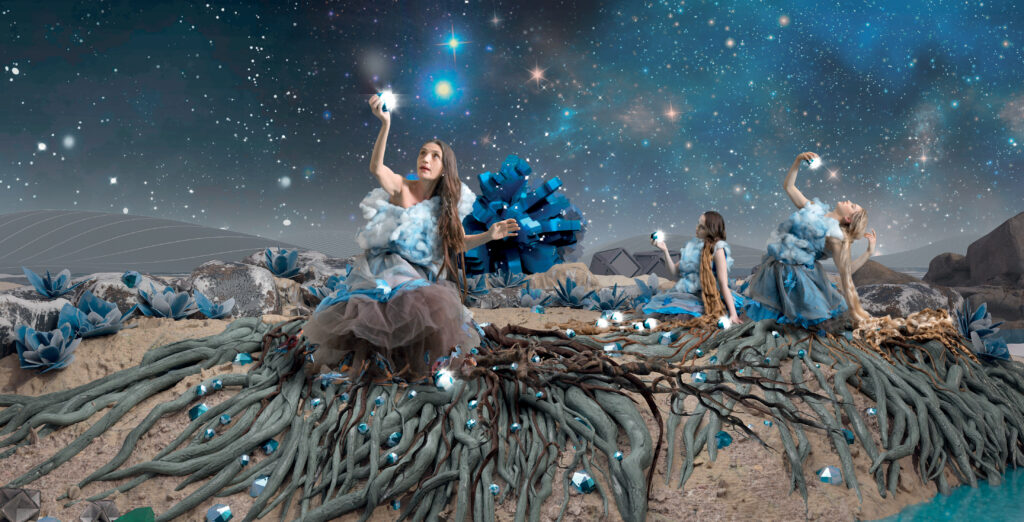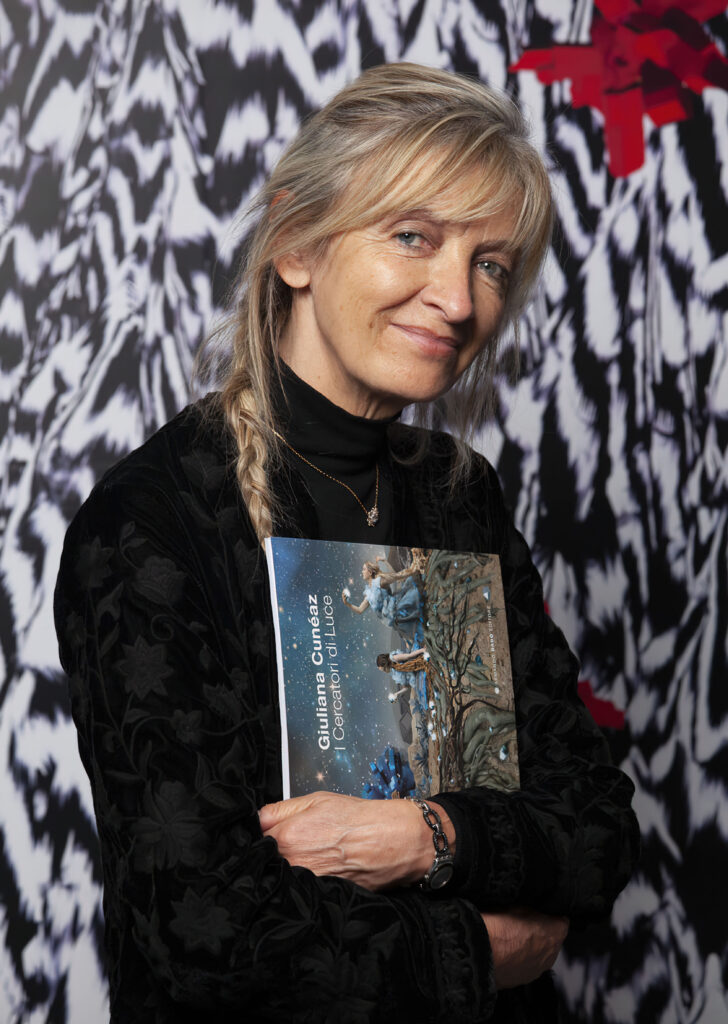
Friday, March 13 – Sunday, March 30
I CERCATORI DI LUCE
Giuliana Cuneaz
Chapelle du couvent de Beaurepaire
Opening time :
Monday to Saturday from 1 pm to 7 pm
Sunday from 2 pm to 6 pm
Free access
This post is also available in: Français (French)

Friday, March 13 – Sunday, March 30
Opening time :
Monday to Saturday from 1 pm to 7 pm
Sunday from 2 pm to 6 pm
Free access
I Cercatori di Luce (The Seekers of Light), 2021, a three-screen video installation, 35 min.
Giuliana Cunéaz’s filmic work, created using the most sophisticated technologies, combines cinema, dance, theater, and performance. Within this highly evocative piece, real figures move through entirely reimagined 3D landscapes. The result is a grand tableau exploring nature’s regenerative power through a slow journey from darkness to light. The Seekers of Light, carrying a profound social and ecological message, represents cutting-edge research in technical experimentation.
Among its protagonists is the acclaimed Spanish actress Ángela Molina, known for her work with legendary directors such as Luis Buñuel and Pedro Almodóvar. The piece also features Aida Accolla, former prima ballerina of La Scala; Giulia Staccioli, choreographer, director, and founder of the Kataklò Academy; model Aurora Talarico; and art historian Bruno Corà. The soundtrack is composed by Paolo Tofani.
Choreographer & director: Giulia Staccioli
Participants: Angela Molina,Mohamed Ba, Barbara Caviglia, Paola Corti, Andrea Damarco, Valeriano Gialli and Stefania Tagliaferri.
Art historian & critic: Bruno Corà
Music: Paolo Tofani
Program supported by the Italian and Lyon Cultural Institute
Giuliana Cunéaz (Aosta, 1959) is an artist specializing in new media art. A graduate of the Accademia di Belle Arti in Turin, she works across various artistic media, including video installations, sculpture, photography, painting, and screen painting. Since the early 2000s, she has been creating her works using computer graphics. In 2004, she was among the first artists to explore 3D technology as part of her research, which focuses on the intersection of science and technology. Her experiments blend virtual and material components, resulting in numerous sculptural works rooted in different areas of inquiry.
In recent years, immersiveness has become a central feature of her work, as exemplified by her three-screen film piece I Cercatori di Luce (The Seekers of Light), created in 2021. Since 2023, she has been employing artificial intelligence with particularly innovative results. Giuliana Cunéaz has showcased her work in numerous solo and group exhibitions in Italy and abroad. In 2021, she became part of the Quirinale Contemporary Collection. Among the notable events she has participated in are the São Paulo Biennial, Tina B. in Prague, Videoformes in Clermont-Ferrand, the Youniverse Seville Biennial, Anteprima Torino as part of the Rome Quadriennale, Project Daejeon, and the Mantua Light Art Biennial.
Artist’s website: https://www.giulianacuneaz.com/

Interview by Fanny Bauguil (VIDEOFORMES relay teacher)
I Cercatori di Luce is an immersive video installation projected onto three screens, lasting around 30 minutes. The work combines cinema, dance, theater and performance. All the characters are real, while the landscapes are virtual, created in 3D. It’s difficult to define exactly what one sees or hears, as the work was conceived as an individual, immersive experience. There is no real plot, but rather a flow of images traversed by characters performing concrete actions. There is no dialogue, but rather sounds, music and dance (the costumes were designed and handmade by myself, in collaboration with scenography students) that give rise to a collective ritual, also engaging the spectator on an emotional level. The transition from darkness to light is subtle, almost imperceptible, but as the actions unfold, everything tends to transform in an evolutionary process leading to a new dimension where solidarity and mutual acceptance prevail. In short, all that’s left to do is watch and listen, trying to grasp the many messages the work contains. The film is accompanied by music by Paolo Tofani, a former member of Area (International POPular Group), one of the most experimental groups of the 1970s. Numerous protagonists take part in the work, including the great Spanish actress Angela Molina, who has worked with directors such as Luis Buñuel and Pedro Almodóvar. Also featured are Aida Accolla, former principal dancer at Milan’s Teatro alla Scala; Giulia Staccioli, choreographer, director and founder of Milan’s Kataklò Academy; model Aurora Talarico; and art historian Bruno Corà.
The work conveys a social message. Each individual is absorbed in the quest for the light needed to regenerate nature. There are many identities, seemingly from different cultures and eras, but all living in harmony with themselves and others. The work addresses three main themes: ecology, identity and work. Among the installation’s components are large rotating sculptures, symbolizing stars in childbirth, which produce precious diamonds as regenerative elements. A mill is also present, collecting water and transforming it into energy to power the planet. Slowly, the darkness fades, and by the end of the projection, a multitude of children are waiting to build a New World.
The video installation has already been presented at the Palacinema in Locarno, the Meet Digital Culture Center in Milan and Cyfest in Yerevan, Armenia. However, this is the first time it has been shown in France. It’s a very elaborate work, which took three years to complete. The creative process can be described as follows: it all began with the storyboard and screenplay, followed by the search for a producer and technical partners, and the building of the crew. Once these steps were completed, I began the executive phase, characterized above all by the 3D modeling of all the scenes. I then proceeded with casting to select the characters and assign them roles. At the same time, I designed the costumes and props, and collaborated on the choreography and music. It was only at this stage that the green screen shooting began, with my directing work integrating the interactions between the real characters and the virtuality of the 3D landscapes. The shoot lasted around ten days, followed by a long post-production phase. This involved several complex stages, including pre-editing on three screens, compositing, editing, color optimization and correction, special effects and animation, audio editing and end titles.
I conduct my research on my own and, in general, I move with great freedom, even in fields seemingly far removed from art, such as science or anthropology. I consider myself a curious person, with a multitude of interests. As a child, I designed costumes and dreamed of doing theater. As far as art is concerned, I like works that stir my emotions and make me think. I prefer works that surprise me and take experimental paths. On the other hand, I’m not interested in works that are purely pop or content-driven, or in the “special effects” that can result from the use of digital technology. I Cercatori di Luce has no specific aesthetic references, although I have drawn inspiration from past cultures. I have often found inspiration in atlases of lost cities, as well as in images derived from nanotechnology. My passions for magic and the world of fantasy are also present, although I’ve always avoided referring to surrealism. Generally speaking, there are many artists I appreciate. Among the masters of the past, I would mention Giorgio de Chirico, Paul Klee and Vincent van Gogh. In 2005, I dedicated one of my first 3D videos, Les Mangeurs de pommes de terre (I Mangiatori di patate), to Vincent van Gogh.
Among contemporary artists, I’m fascinated by the work of William Kentridge and Pierre Huyghe, but I can also be inspired by works by younger artists. At the last Lyon Biennale, I found the work of Slovakian artist Robert Gabris particularly interesting. Art has no age: a beautiful work is immortal.
I Cercatori di Luce was a very difficult project. I consider this work to be my Sistine Chapel… The main difficulty was certainly obtaining the necessary funding and finding partners interested in the project. Fortunately, the project met with immediate approval, and many people supported me. Contact with CISA – the International Conservatory of Audiovisual Sciences in Locarno – was crucial, as it enabled me to shoot the film. Finding actors was also a complex process, but I managed to involve Angela Molina, who embodies the film’s central character. Collaborations with Milan’s NABA (New Academy of Fine Arts) and Milan’s Kataklò Academy, directed by Giulia Staccioli, as well as a meeting with the great dancer Aida Accolla, were also decisive. The latter, after more than thirty years, came back to dance especially for me. On a technical level, the production was a real challenge. More broadly, my work has always represented a form of challenge, because I’ve never wanted to conform to or repeat previously assimilated patterns. I’ve never imposed limits on myself, which has led me to create works that seem very different from one another. This has not always led to immediate recognition of my style. I’ve never tried to please others, nor thought about the market. This independence has sometimes caused me difficulties in carrying out my projects. But I’m proud to have followed this uncompromising path. To undertake such work, you need immense passion, tenacity, consistency and confidence in your own path. You have to face up to the loneliness and skepticism of many people, and never give in to the temptations of money or easy success.
You can visit my website www.giulianacuneaz.com and follow me on Instagram via the account giuliana_cuneaz.
3D, nanotechnology, video-installation, dance, theater, music, costumes, actors, lights, darkness, regeneration, sustainability, cultures, ecology, energy, community, solidarity.
I started when I was a teenager and haven’t stopped since. My first works were environmental installations. Later, I produced a number of video works, frequently mixing this language with other installation techniques. In 2003, I started working with 3D, and since 2023, I’ve been using artificial intelligence. I’ve always enjoyed creating dialogues between the material and virtual worlds, establishing relationships between them to generate new synergies, sometimes unpredictable even for me. Although my research is very consistent, the themes I tackle vary. At certain times, it’s science-related subjects that dominate, while at others, it’s those connected to the magical and imaginary world. For me, there’s no contradiction: both contain secrets and great mysteries… I could define myself as an artist and interpreter of mystery. Concerning your question about making a living from my creative activity, I can tell you that I’ve been making a living from it since 2002, although it hasn’t been without its difficulties. Before that, I supplemented my research with other activities. I was a teacher and worked with the Regional Archaeological Museum of Aosta.